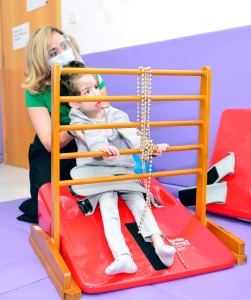Occupational Therapy Services

What is occupational therapy for children?
Occupational therapy for children is a type of therapy that aims to enhance children’s daily abilities and skills and help them achieve maximum independence in performing daily activities and interacting with their surroundings. Occupational therapy uses a variety of methods and techniques to help children improve their skills in areas such as movement, balance, muscle strength, sensorimotor, motor coordination, and motor control.

A child may need occupational therapy when he or she faces challenges in performing daily activities independently or when there is a negative impact on the quality of his or her daily life and interaction with the surrounding environment.
Doctors or specialists in normal development, education, or mental health may refer to occupational therapy if they notice any of the following signs:
- Difficulties with movement and mobility: When the child shows difficulties with general movement such as walking, climbing or sitting independently.
- Difficulties with motor coordination: When the child has difficulty coordinating simple movements or performing activities that require precision of movement.
- Difficulties with daily activities: When the child finds it difficult to perform daily activities such as dressing, feeding, and personal hygiene.
- Delay in achieving motor and sensory abilities: When the child shows a delay in achieving the motor and sensory skills expected for his or her age.
Difficulties with social interaction and communication: When the child has difficulty interacting with others or communicating verbally or nonverbally.
What are the most important activities included in occupational therapy?
Occupational therapy for children includes several activities and tasks, you can learn about them now:
What are the most prominent problems that require occupational therapy to solve?
There are many problems that occupational therapy can treat. Among these problems are:
- Delayed motor development: When a child has difficulty achieving the motor skills expected for his age, such as walking, crawling, and jumping.
- Poor sensory abilities: When a child has difficulty using the five senses (sight, hearing, touch, smell, and taste) effectively in his daily activities.
- Delayed speech and language: When a child has difficulty developing natural language and speech skills for his age.
- Communication and social interaction difficulties: When a child has difficulty communicating with others effectively or understanding social interactions.
- Movement difficulties resulting from injuries or disabilities: Such as cerebral palsy, quadriplegia, spinal paralysis, muscle tension, and other conditions that affect the ability to move and balance.
- When a child has difficulty understanding academic concepts and acquiring basic skills at school.
- Behavioral and self-regulation difficulties: Such as loss of concentration, hyperactivity, and difficulties in organization and implementation.

